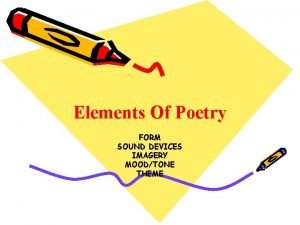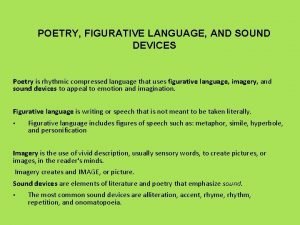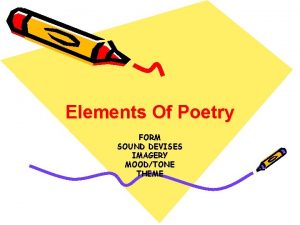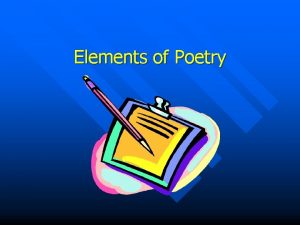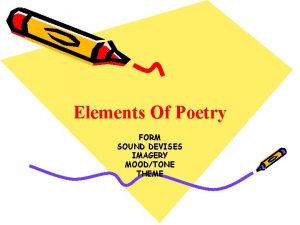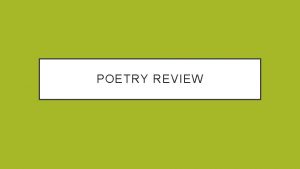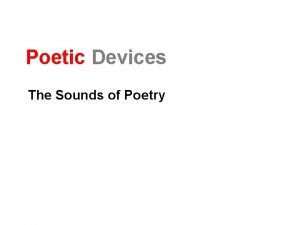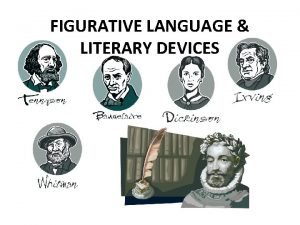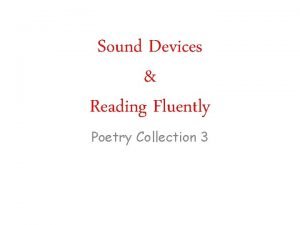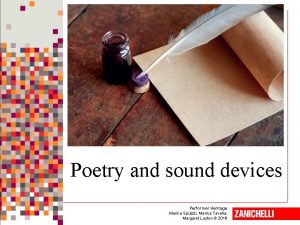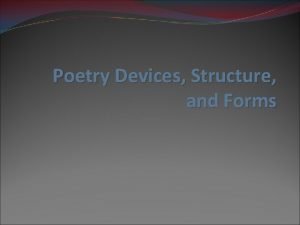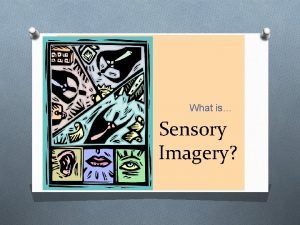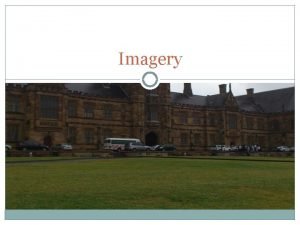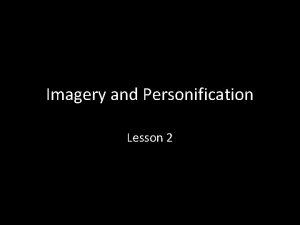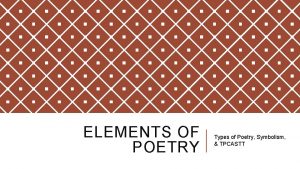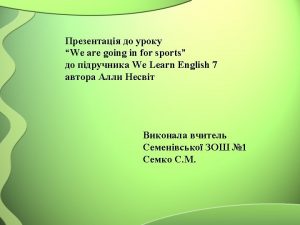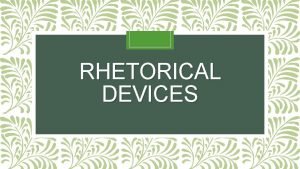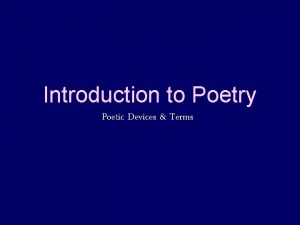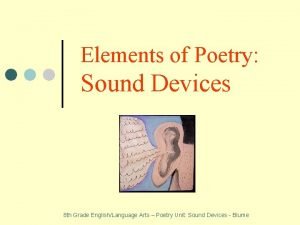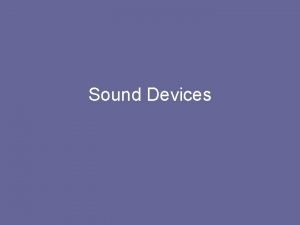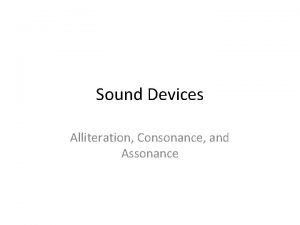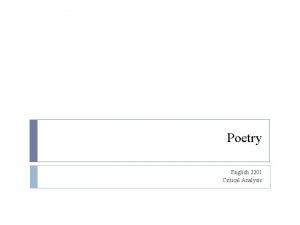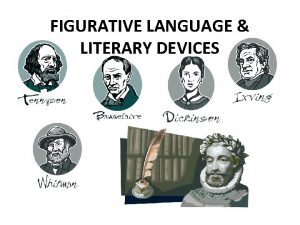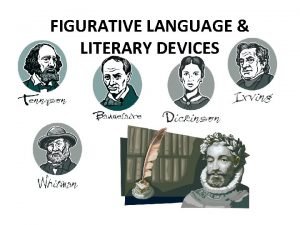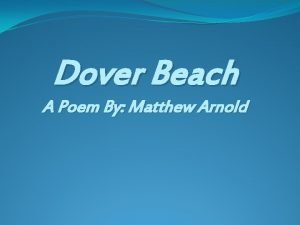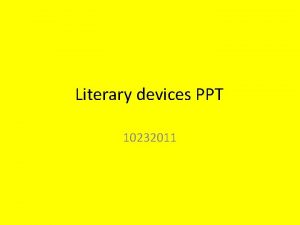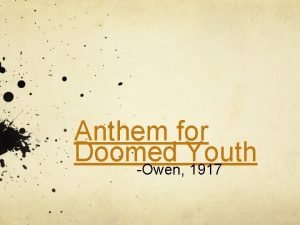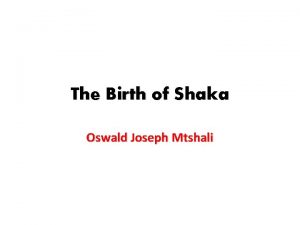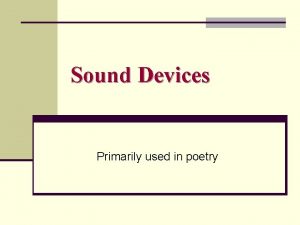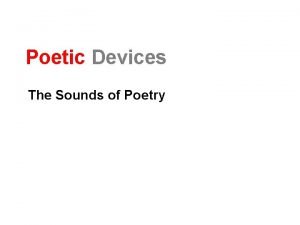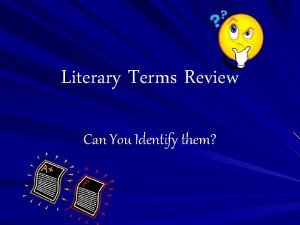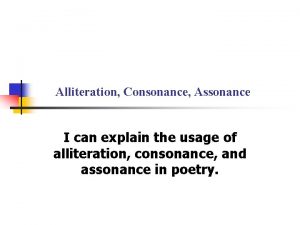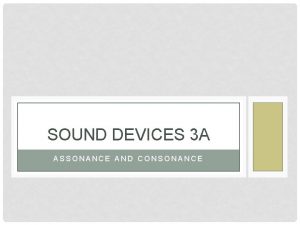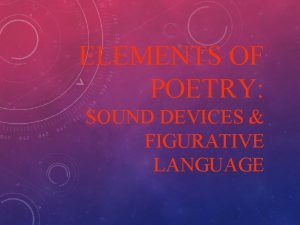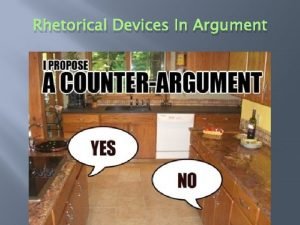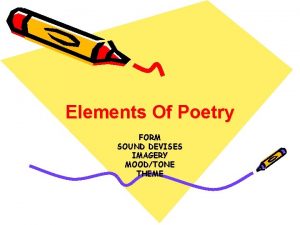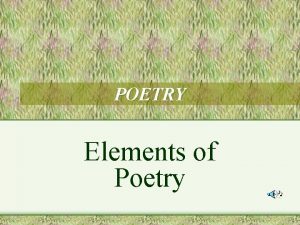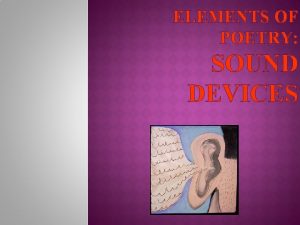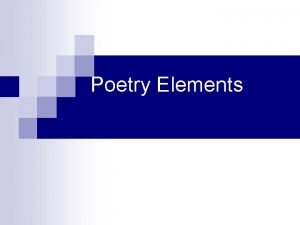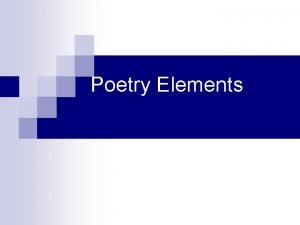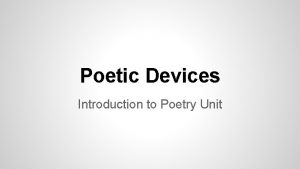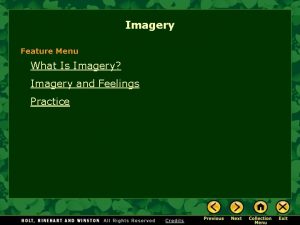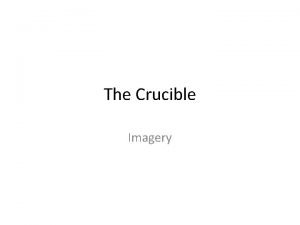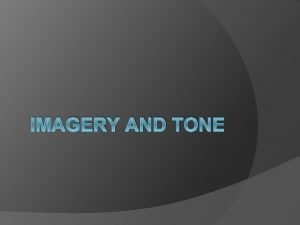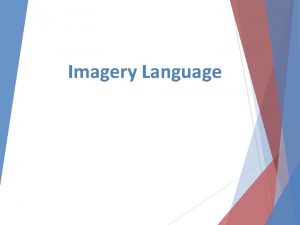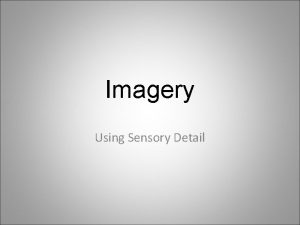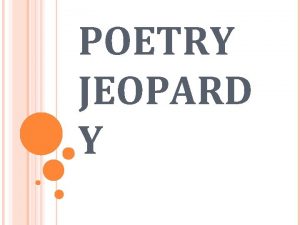Elements Of Poetry FORM SOUND DEVICES IMAGERY MOODTONE










































- Slides: 42

Elements Of Poetry FORM SOUND DEVICES IMAGERY MOOD/TONE THEME

Poetry: Poetry is a form of writing that uses not only words, But also form, Patterns of sound, Imagery, And figurative language To convey the message. Any Poem will include some or all of these elements.

FORM: • • A poem’s form is its appearance. Poems are divided into lines. Many poems, especially longer ones, may also be divided into groups of lines called stanzas. Stanzas function like paragraphs in a story. Each one contains a single idea or takes the idea one step further. What is the purpose of the first stanza of “The Highwayman”? The wind was a torrent of darkness, among the gusty trees. The moon was a ghostly galleon tossed upon cloudy seas. The road was a ribbon of moonlight over the purple moor, And the highwayman came riding Riding – riding – The highwayman came riding up to the old inn door. Sets the scene

• Couplet: • Two lines in a poem that rhyme • Quatrain: • Four lines that usually have alternating rhyme

Narrative Poetry • Tells a story; has a plot • Examples: “The Highwayman” • “The Raven” • https: //www. youtube. com/watch? v=b Li. Xja. Pq. Sy. Y

Ballad • A song or poem that tells a story • Pattern: mostly written in quatrains with patterns of rhyme to make them easier to recite or sing. • Ex: “The Challenger” • https: //www. youtube. com/watch? v=Afnv. Fnzs 91 s https: //www. youtube. com/watch? v=BWn. V 1 V 5 t. YUw • Many Country songs

SOUND Devices Some poems use techniques of sound such as rhythm, rhyme, and alliteration.

Rhythm: • The pattern of beats or stresses in a poem. Poets use patterns of stressed and unstressed syllables to create a regular rhythm. Try beating out the rhythm with a finger as you read these lines. She was a child and I was a child, In this kingdom by the sea; But we loved with a love that was more than love – I and my Annabel Lee;

Edgar Allan Poe

Meter • A consistent rhythm, rhythm combined with lines of set length, create a poem’s meter.

RHYME: The repetition of the same or similar sounds, usually in stressed syllables at the ends of lines, but sometimes within a line. There are strange things done in the midnight sun By the men who moil for gold;

Cremation of Sam Mc. Gee By Robert William Service

Rhyme cont. End Rhyme Internal Rhyme • The words at the END of the line rhyme. • Rhymes within the same line • (this is one example) • Ex: Roses are red, Violets are blue, Sugar is sweet, And so are you! • I went to town to buy a gown. I took the car and it wasn’t far

Rhyme Scheme The rhyming pattern that is created at the end of lines of poetry. Mary had a little lamb, Its fleece as white as snow. And everywhere that Mary went, The lamb was sure to go. A B C B If the poem does not have a rhyme scheme it is considered to be a free verse poem.

Repetition The repeating of a particular sound device to create an effect. To create emphasis, a poet may repeat words or lines within the poem.

Free Verse • No pattern of repeated rhyme or rhythm • Does use repeated sounds to create a musical quality to emphasize meaning

Her Daddy’s Hands • • • • His hands, you see, Mama says were hard and callused. They worked all day making bricks that made houses he’d show her as he flew his noisy pick-up down the red Alabama roads. But on Sundays, those hands, you see felt soft, and would hold my mama’s and walk her to church. Quietly. Him in black, her in white along those red Alabama roads.

Angela Johnson

Mood The atmosphere the author establishes using word choice. Ex: Think of the Jaws music and the mood it creates! https: //www. youtube. com/watch? v=5 t. Mqc. ARKRSE Think of how the setting is set up; a graveyard, at night, with a full moon, bats flying around, and noises in the background. What kind of mood is being developed?

Tone • The writer’s attitude toward the subject he or she is writing about or toward the reader. • #sarcasm • Ex: Think of when an adult asks you to apologize when you don’t want to. You say the words, but your tone lets us know you aren’t really sorry. – Modest Proposal by Jonathan Swift – https: //andromeda. rutgers. edu/~jlynch/Texts/modest. html

THEME: The theme is the basic or universal truth that goes beyond the actual story. It should be more than one word. You can say theme is love, but that isn’t enough. What is the truth about love? Love hurts? Love is forever? Better to have love and lost than never love at all? Love is blind? To identify a poem’s theme, ask yourself what ideas or insights about life or human nature you have found in the poem.

Haiku • Tulips – Pushing through moist earth – tulips leave no room for doubt: – spring is here at last. – By Sarita Chavez Silverman

Haiku • • • Japanese in origin Three lines Syllables 5 -7 -5=17 syllables Topic is about nature Don’t write three separate sentences. no rhyming

Other types of poems • Concrete: makes a picture on the page. The picture is what the poem is about.

Limerick • • A five line rhymed, rhythmic verse Usually humorous or silly Rhyme scheme is usually aabba Two rhyming couplets with the last line rhyming with the first couplet

Limerick example

Limerick • There was an old man of Khartoum • Who kept a tame sheep in his room, • “To remind me, ” he said, • “Of someone who’s dead, • But I never can recollect whom. ”

Sound devices • Alliteration • Onomatopoeia

ALLITERATION: The repetition of consonant sounds at the beginnings of words. Seven silver swans swam silently seaward. Peter Piper pick a peck of pickled peppers.

Onomatopoeia Words that are used to represent particular sounds. Crash Bang Boom Zip

IMAGERY Poets use words that appeal to the reader’s senses of sight, sound, touch, taste, and smell. Which senses does the following stanza appeal to? Back, he spurred like a madman, shouting curses to the sky, With the white road smoking behind him and his rapier brandished high. Sight? Sound?

FIGURES OF SPEECH: Figures of speech are a special kind of imagery. They create pictures by making comparisons.

SIMILE A comparison using like or as. Talk of your cold! through the parka’s fold it stabbed like a driven nail.

METAPHOR: Describes one thing as if it were another. The moon was a ghostly galleon tossed upon cloudy seas.


Carl Sandburg

Extended Metaphor A metaphor that extends throughout the entire poem instead of just a few lines of the poem.

Langston Hughes

Mother to Son By: Langston Hughes Well, son, I’ll tell you: Life for me ain’t been no crystalstair. It’s had tacks in it, And splinters, And boards torn up, And places with no carpet on the floor – Bare. But all the time I’se been a-climbin on, And reachin’ landin’s, And turnin’ corners, And sometimes goin’ in the dark Where there ain’t been no light. So, boy, don’t you turn back. Don’t you set down on the stops ‘Cause you finds it kinder hard. don’t you fall now – For I’se still goin’, honey, I’se still climbin’, and life for me ain’t been no crystal stair.

PERSONIFICATION: Gives human characteristics to something nonhuman. …and the stars o’erhead were dancing heel and toe…

In “The Highwayman, ” images create a picture of Tim. Which figures are used to describe his eyes and his hair? His eyes were hollows of madness, his hair like moldy hay, eyes : hollows of madness : Metaphor hair : moldy hay : Simile

Which figures are used to describe the following? • My love is like a rose. • Simile • Our love bloomed in the garden. • Personification • The rose tipped its head as we passed by. • Personification
 Moodtone
Moodtone Poem with sound devices
Poem with sound devices Is hyperbole a sound device
Is hyperbole a sound device Poem consonance
Poem consonance Elements of poem with examples
Elements of poem with examples Mood elements of poetry
Mood elements of poetry Example for internal rhyme
Example for internal rhyme Drip hiss the rain never stops
Drip hiss the rain never stops Quatrain
Quatrain Sound devices definition poetry
Sound devices definition poetry Poetry and sound devices zanichelli
Poetry and sound devices zanichelli Olfactory imagery examples
Olfactory imagery examples Sight imagery
Sight imagery Good imagery poems
Good imagery poems Example of visual imagery poem
Example of visual imagery poem A dream within a dream tpcastt
A dream within a dream tpcastt What is imagery in poetry
What is imagery in poetry Imagery sinners in the hands of an angry god
Imagery sinners in the hands of an angry god “a sound mind is in a sound body”
“a sound mind is in a sound body” How is sound produced
How is sound produced Symbol rhetorical device
Symbol rhetorical device Repetition in poem example
Repetition in poem example 8 elements of poetry
8 elements of poetry Assonance
Assonance Consonance vs alliteration
Consonance vs alliteration The whaups poem analysis
The whaups poem analysis Is repetition a figurative language
Is repetition a figurative language Sound device alliteration
Sound device alliteration Sophocles long ago heard it on the aegean explanation
Sophocles long ago heard it on the aegean explanation Oxymoron literary device
Oxymoron literary device Poetic techniques in anthem for doomed youth
Poetic techniques in anthem for doomed youth Syringa thorns
Syringa thorns N alliteration
N alliteration Songs with poetic devices
Songs with poetic devices Drip hiss the rain never stops
Drip hiss the rain never stops The sound of silence literary devices
The sound of silence literary devices What is aliteration
What is aliteration Twinkle twinkle little star figurative language
Twinkle twinkle little star figurative language The effect of assonance
The effect of assonance There once was an ape in a zoo limerick
There once was an ape in a zoo limerick What language is this
What language is this Literary devices in the sound of waves
Literary devices in the sound of waves A regular pattern of sound words or musical notes
A regular pattern of sound words or musical notes

